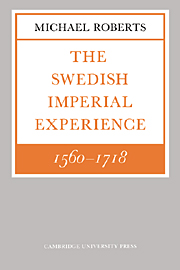IV - The unmaking of the empire
Published online by Cambridge University Press: 06 January 2010
Summary
when an empire no longer serves the purposes for which it was created, and has in the meantime discovered no new justification for its existence, it is ripe for its fall. If we are to attempt some explanation of the collapse of the Swedish empire, one useful line of approach may be to enquire how far, in the half-century after 1660, the empire in fact answered the expectations of its architects. This threatens, of course, to bring us back to that controversy between the Old School and the New, discussed in chapter I. But if the New School is right, if the empire was created for the purposes of commercial monopoly, then our question is easily answered. For such a monopoly was never in sight of attainment: Breitenfeld had been fought in vain, the gains of Westphalia were irrelevant decorations. The empire made no sense; and there is no need to protract the discussion beyond this point.
But if the New School has got its proportions wrong? If we assume that the expansion was basically defensive in motivation, that the objective was security, and the means to ensure that that security should be real: what then? From this point of view, the results of Sweden's efforts were undeniably impressive: the outcome seemed to answer the design. They had set bounds to what they called ‘Russian barbarism’, and shut off Moscow from the sea.
- Type
- Chapter
- Information
- The Swedish Imperial Experience 1560–1718 , pp. 123 - 156Publisher: Cambridge University PressPrint publication year: 1979



